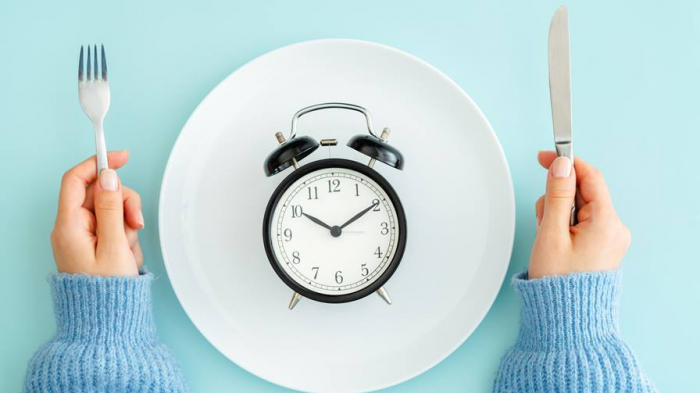Intermittent fasting is championed by celebrities and CEOs alike for its weight loss and health benefits. While there is promising evidence that fasting can help our bodies repair and perhaps extend our lifespans, it might not be the best approach for losing weight, and dietitians urge caution before cutting out meals.
Intermittent fasting is a type of time-restricted diet in which fasters leave a long gap between their last meal of one day and first of the next, compressing their meals into a shorter period during the day. Typically, fasters try to leave a gap of 16 hours without food and eat during an eight-hour window. Intermittent fasting is not the only type of time-restricted diet. Others like the 5:2 diet (in which dieters eat a normal amount of food for five days before two days of eating only 25% of their usual calorie intake) focus more on the amount of food consumed, rather than the time between meals.
“Time-restricted feeding is used as a weight-loss tool, but it’s not my favorite approach,” says Rachel Clarkson, founder of London-based consultancy The DNA Dietitian. “You reduce calories but you don’t learn the essential behavior change around what you're putting into your body.”
Clarkson says that without learning what a healthy diet looks like people gain weight again when they stop fasting. “If it means you are feeling starved and restricted then the next day you might over-eat.
So, intermittent fasting might not be the right approach for people seeking weight loss, but there might be other reasons to change your eating patterns. Fasting is linked to a process called autophagy, which is attracting a lot of interest for its potential health benefits.
Autophagy is the process by which the body starts to recycle the structures inside its cells, including the nucleus, where DNA is stored, the mitochondria, which synthesise the chemical our cells use for energy, and lysosomes, which remove waste from our cells. In doing so, the cell can remove defunct structures, freeing up new raw materials from which new cellular structures can be built. Some of the new raw material might be used to make cell-protective proteins that further extend the lifespan of cells.
There is interest in whether autophagy can increase the lifespan of whole organisms, too – though so far this has only been replicated in animals, like 1mm-long nematode worms and mice, and not humans (inhibited autophagy has also been linked to early-onset ageing). Until there are longitudinal studies of human intermittent fasters, it is too soon to say that it will extend our lifespans.
But, other animal studies have linked autophagy to improvements in immune system memory. The fact that autophagy is essential to maintain cell health has also generated interest in its role in cancer suppression. There might be more reasons than increasing lifespan to take interest in autophagy.
For most of us, autophagy occurs in our sleep, but it is also brought on by exercise and starvation. Could controlled fasting help to trigger it?
Unlike calorie-restrictive diets (which have also been linked to longevity), the purpose of intermittent fasting is to increase the amount of time between the last meal of one day and the first of the next. (In theory, an intermittent faster could eat the same amount of calories as normal, though in practice Clarkson says most people reduce their intake slightly.) This could help to promote autophagy, but to understand how we should look at what happens to us after we eat.
“When you stop eating at 19:00 you will still be in the ‘fed state’ until 22:00 because you will still be digesting nutrients,” says Clarkson. “Any carbohydrates in your diet will give you a nice supply of glucose, our premium source of fuel, for a few hours.”
The fed state is when your body uses glucose in your blood as its source of energy. Once this energy source is used up, the body switches into a catabolic state – usually around three hours after eating. In this phase, glycogen stored in the liver and muscles is broken down into glucose. When we have depleted the glycogen stores, the body switches from glucose to ketones, which are made in the liver from fatty acids. It’s at this point, a stage called ketosis, that autophagy is triggered.
“We don’t know exactly when we shift from glucose to ketones,” says Clarkson. “It depends on so many things; genetics, health, lifestyle. How much glycogen you have will be based on how much you have eaten and how much energy you have burned.”
Someone who has a high-carb diet might never move beyond the catabolic state as they will always have a reserve supply of glycogen. However, someone with a low-carb diet and who regularly exercises might move through it very quickly (the “keto diet”, in which you cut out almost all carbs to maintain low blood glucose levels and glycogen stores, works in the same way). “I would move away from intermittent fasting for fat loss, and if you want to adopt it think about the health benefits,” says Clarkson.
How to fast
“To fast you have to downregulate the feeling of hunger,” says Clarkson. Hunger is felt when ghrelin, a hormone released from our stomach, triggers the production of two other hormones, called NPY and AgRP, in the hypothalamus.
While these three hormones generate feelings of hunger, there are a multitude more that suppress it. Sometimes called the “satiety hormones”, one of the key ones is leptin which is released from fat cells to suppress the production of ghrelin – basically telling the body "there is fat here that you can burn".
Ghrelin is sometimes called the short-term hunger response because it is released when the stomach is empty and there is less pressure on the stomach wall. It can be overridden to a certain extent by drinking water. Leptin meanwhile works over the long term.
“Our hunger hormones are regulated by many things, genetics being one of them,” says Clarkson. “But thinking about the nerves that are attached to our stomach and digestive tract – if your stomach is not distended your body will think it is hungry.” She adds that staying hydrated can help with the early feelings of hunger until your body has adjusted. “The first couple of weeks will be tough, but you get used to it.”
For most people, ketosis occurs 12-24 hours after eating, so if you have your evening meal between 18:00 and 20:30, the fed state would end between 21:00 and 23:30 and ketosis and autophagy might occur by 06:00 to 08:30 the following morning. “But the majority of people are sitting down and opening a packet of something else after dinner,” says Clarkson. “Snacking or sugary drinks and beer extend the fed state for three hours. If you finish snacking at 21:30-22:00, the fed state is being taken to 01:00-03:00,” she says. This might mean ketosis never occurs before you next have a meal.
“If you can make the informed decision of eating the evening meal an hour earlier and not snacking, you may be getting into that ketosis state by morning, versus someone who is having the high-carb evening meal and snacking, waking up at 06:00 and never getting into that state,” she says. Clarkson suggests starting by eating earlier on a Sunday evening, or having breakfast an hour later and starting from there, building up from one or two days each week.
With a careful approach, intermittent fasting might help your body to perform its own repairs and recoveries. Autophagy appears to decline with age, so giving yourself a boost later in life might be useful. But be aware that it might not be the right strategy for weight loss, and there is no replacement for a balanced diet.
BBC
More about:















































